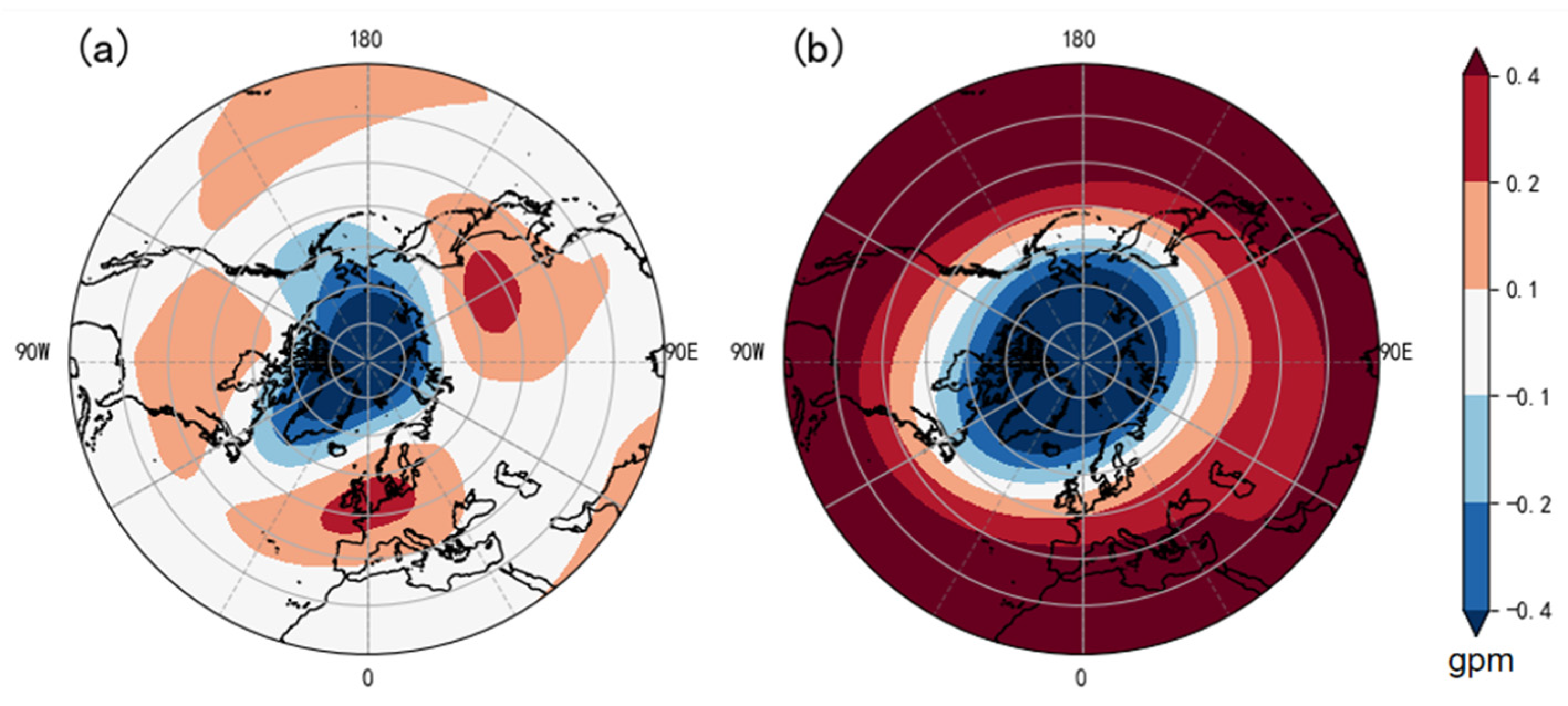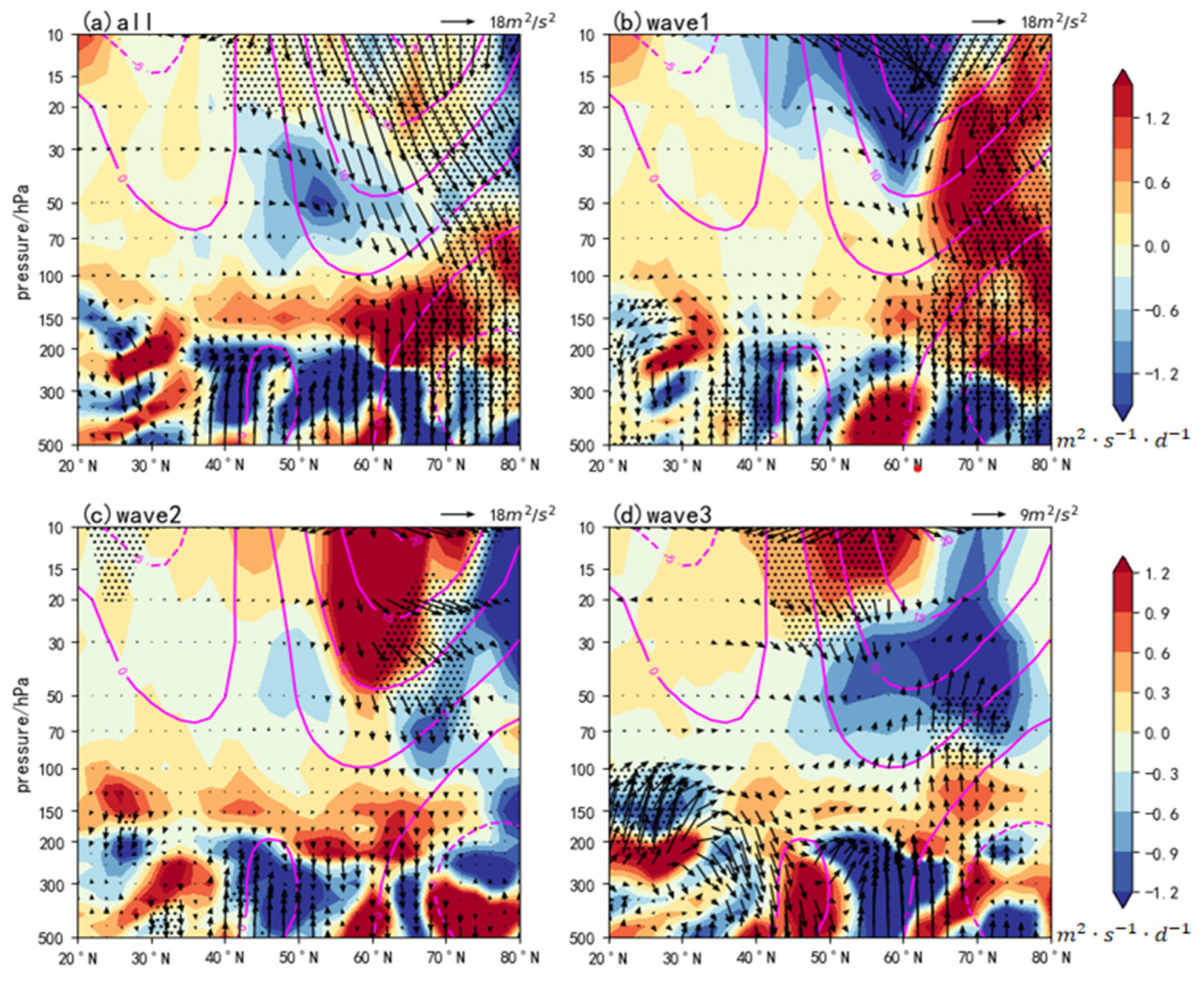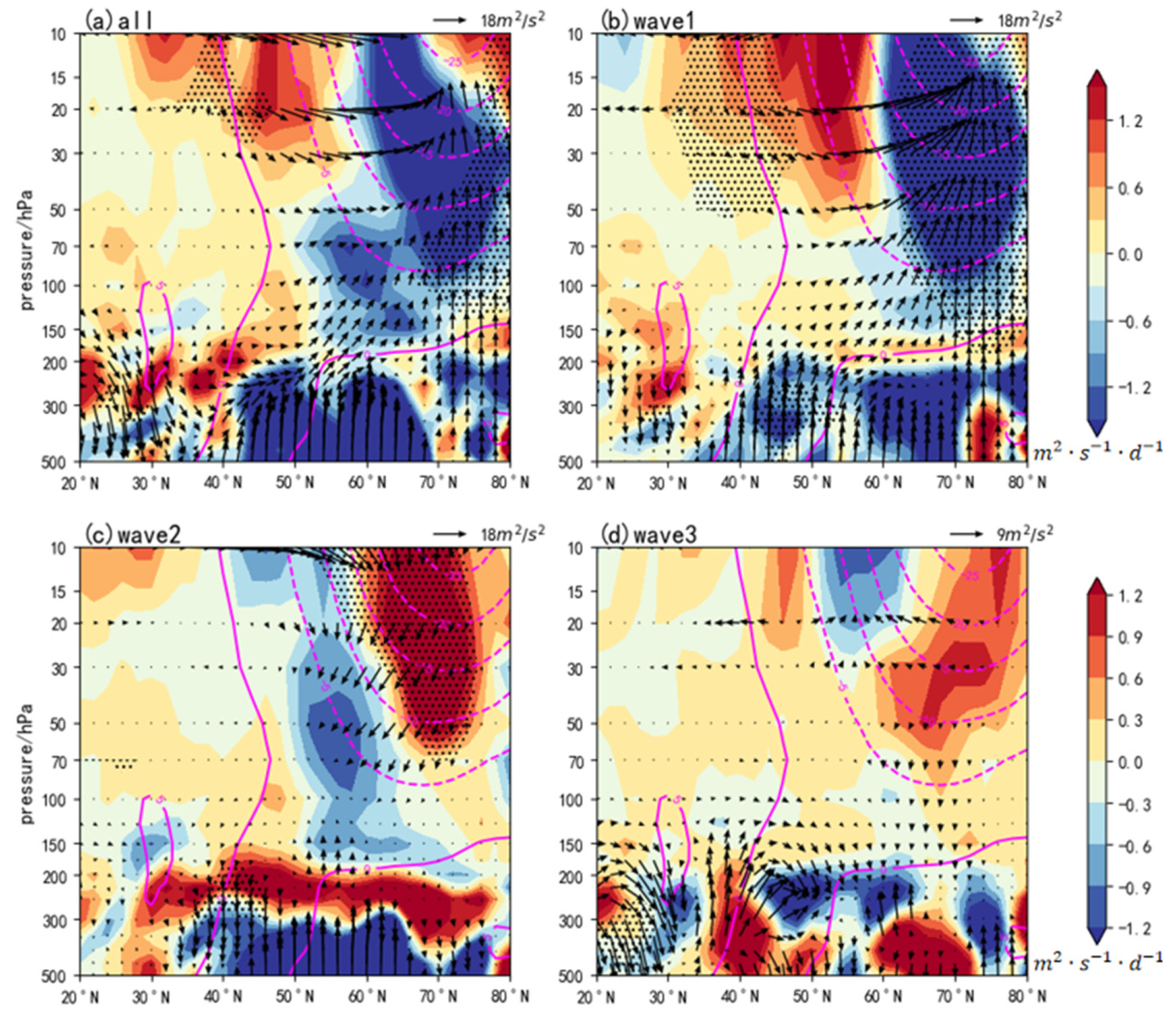Types of Coupling between the Stratospheric Polar Vortex and Tropospheric Polar Vortex, and Tropospheric Circulation Anomalies Associated with Each Type in Boreal Winter
Abstract
:1. Introduction
2. Data and Methods
2.1. Data
2.2. Methods
2.2.1. Empirical Orthogonal Function
2.2.2. Harmonic Analysis
2.2.3. E-P Flux
3. Types of Coupling between the Stratospheric PV and Tropospheric PV
3.1. The Definition of Strong PV and Weak PV
3.2. Types of Coupling between the Stratospheric PV and the Tropospheric PV
4. Vertical Propagation Characteristics of Planetary Waves in Four Types of PV Anomalies in Both the Stratosphere and the Troposphere
5. Tropospheric Circulation Anomalies Associated with Four Types of PV Anomalies in Both the Stratosphere and the Troposphere
6. Conclusions and Discussion
Author Contributions
Funding
Data Availability Statement
Acknowledgments
Conflicts of Interest
References
- Baldwin, M.P.; Cheng, X.; Dunkerton, T.J. Observed correlations between winter-mean tropospheric and stratospheric circulation anomalies. Geophys. Res. Lett. 1994, 21, 1141–1144. [Google Scholar] [CrossRef]
- Huang, R.H.; Chen, W.; Wei, K.; Wang, L.; Huangfu, J.L. Atmospheric Dynamics in the Stratosphere and Its Interaction with Tropospheric Processes: Progress and Problems. Chin. J. Atmos. Sci. 2018, 42, 463–487. [Google Scholar] [CrossRef]
- Quiroz, R.S. The tropospheric-stratospheric polar vortex breakdown of January 1977. Geophys. Res. Lett. 1977, 4, 151–154. [Google Scholar] [CrossRef]
- Nigam, S. On the Structure of Variability of the Observed Tropospheric and Stratospheric Zonal-Mean Zonal Wind. J. Atmos. Sci. 1990, 47, 1799–1813. [Google Scholar] [CrossRef]
- Kolstad, E.W.; Breiteig, T.; Scaife, A.A. The association between stratospheric weak polar vortex events and cold air outbreaks in the Northern Hemisphere. Q. J. R. Meteorol. Soc. 2010, 136, 886–893. [Google Scholar] [CrossRef]
- Kretschmer, M.; Cohen, J.; Matthias, V.; Runge, J.; Coimou, D. The different stratospheric influence on cold-extremes in Eurasia and North America. npj Clim. Atmos. Sci. 2018, 1, 44. [Google Scholar] [CrossRef]
- Baldwin, M.P.; Stephenson, D.B.; Thompson, D.W.J.; Dunkerton, T.J.; Charlton, A.J.; O’Neill, A. Stratospheric memory and skill of extended-range weather forecasts. Science 2003, 301, 636–640. [Google Scholar] [CrossRef]
- Sigmond, M.; Scinocca, J.F.; Kharin, V.V.; Shepherd, T.G. Enhanced seasonal forecast skill following stratospheric sudden warmings. Nat. Geosci. 2013, 6, 98–102. [Google Scholar] [CrossRef]
- Kidston, J.; Scaife, A.A.; Hardiman, S.C.; Mitchell, D.M.; Butchart, N.; Baldwin, M.P.; Gray, L.J. Stratospheric influence on tropospheric jet streams, storm tracks and surface weather. Nat. Geosci. 2015, 8, 433–440. [Google Scholar] [CrossRef]
- Plumb, R.A. Planetary Waves and the Extratropical Winter Stratosphere; American Geophysical Union: Washington, DC, USA, 2010. [Google Scholar]
- Charney, J.G.; Drazin, P.G. Propagation of planetary-scale disturbances from the lower into the upper atmosphere. J. Geophys. Res. 1961, 66, 83–109. [Google Scholar] [CrossRef]
- Matsuno, T. Vertical Propagation of Stationary Planetary Waves in the Winter Northern Hemisphere. J. Atmos. Sci. 1970, 27, 871–883. [Google Scholar] [CrossRef]
- Kretschmer, M.; Coumou, D.; Agel, L.; Barlow, M.; Tziperman, E.; Cohen, J. More-Persistent Weak Stratospheric Polar Vortex States Linked to Cold Extremes. Bull. Am. Meteorol. Soc. 2017, 99, 49–60. [Google Scholar] [CrossRef]
- Lawrence, Z.D.; Perlwitz, J.; Butler, A.H.; Manney, G.L.; Newman, P.A.; Lee, L.S.; Nash, E.R. The Remarkably Strong Arctic Stratospheric Polar Vortex of Winter 2020: Links to Record-Breaking Arctic Oscillation and Ozone Loss. J. Geophys. Res. Atmos. 2020, 125, e2020JD033271. [Google Scholar] [CrossRef]
- Cohen, J.; Agel, L.; Barlow, M.; Garfinkel, C.I.; White, I. Linking Arctic variability and change with extreme winter weather in the United States. Science 2021, 373, 1116–1121. [Google Scholar] [CrossRef]
- Huang, W.J.; Wang, L. The stratosphere-troposphere interaction during cold air outbreaks in East Asia associated with the blocking events in the extratropical Northern Hemisphere. Acta Meteorol. Sin. 2023, 81, 218–234. [Google Scholar] [CrossRef]
- Liu, Y.; Zhao, Y.H.; Guan, Z.Y. Influences of Stratospheric Circulation Anomalies on Tropospheric Weather of the Heavy Snowfall in January 2008. Clim. Environ. Res. 2008, 13, 548–555. [Google Scholar]
- Yi, M.J.; Chen, Y.J.; Zhou, R.J.; Deng, S.M. Analysis on Isentropic Potential Vorticity for the Snow Calamity in South China and the Stratospheric Polar Vortex in 2008. Plateau Meteorol. 2009, 28, 880–888. [Google Scholar]
- Baldwin, M.P.; Dunkerton, T.J. Propagation of the Arctic Oscillation from the stratosphere to the troposphere. J. Geophys. Res. 1999, 104, 30937–30946. [Google Scholar] [CrossRef]
- Lu, C.H.; Ding, Y.H. Progress in the Study of Stratosphere-Troposphere Interaction. Adv. Meteor. Sci. Technol. 2013, 3, 6–21. [Google Scholar]
- Limpasuvan, V.; Thompson, D.W.J.; Hartmann, D.L. The Life Cycle of the Northern Hemisphere Sudden Stratospheric Warmings. J. Clim. 2004, 17, 2584–2596. [Google Scholar] [CrossRef]
- Spaeth, J.; Birner, T. Stratospheric modulation of Arctic Oscillation extremes as represented by extended-range ensemble forecasts. Weather Clim. Dyn. 2022, 3, 883–903. [Google Scholar] [CrossRef]
- Gecaite, I. The role of stratosphere-troposphere coupling in the occurrence of wintertime extreme temperature events over the eastern part of the Baltic Sea region. Boreal Environ. Res. 2022, 27, 145–160. [Google Scholar]
- Butler, A.H.; Sjoberg, J.P.; Seidel, D.J.; Rosenlof, K.H. A sudden stratospheric warming compendium. Earth Syst. Sci. Data 2017, 9, 63–76. [Google Scholar] [CrossRef]
- Domeisen, D.I.V.; Butler, A.H.; Charlton-Perez, A.J.; Ayarzagüena, B.; Baldwin, M.P.; Dunn-Sigouin, E.; Furtado, J.C.; Garfinkel, C.I.; Hitchcock, P.; Karpechko, A.Y.; et al. The Role of the Stratosphere in Subseasonal to Seasonal Prediction: 1. Predictability of the Stratosphere. J. Geophys. Res. Atmos. 2020, 125, e2019JD030920. [Google Scholar] [CrossRef]
- Rao, J.; Garfinkel, C.I.; White, I.P.; Chen, S. The Southern Hemisphere Minor Sudden Stratospheric Warming in September 2019 and its predictions in S2S Models. J. Geophys. Res. Atmos. 2020, 125, e2020JD032723. [Google Scholar] [CrossRef]
- Baldwin, M.P.; Ayarzaguena, B.; Birner, T.; Butchart, N.; Butler, A.H.; Charlton-Perez, A.J.; Domeisen, D.I.V.; Garfinkel, C.I.; Garny, H.; Gerber, E.P.; et al. Sudden Stratospheric Warmings. Rev. Geophys. 2021, 59, e2020RG000708. [Google Scholar] [CrossRef]
- Lu, Q.; Rao, J.; Liang, Z.; Guo, D.; Wang, T. The sudden stratospheric warming in January 2021. Environ. Res. Lett. 2021, 16, 084029. [Google Scholar] [CrossRef]
- Kodera, K.; Mukougawa, H.; Fujii, A. Influence of the vertical and zonal propagation of stratospheric planetary waves on tropospheric blockings. J. Geophys. Res. Atmos. 2013, 118, 8333–8345. [Google Scholar] [CrossRef]
- Xia, Y.; Xie, F.; Lu, X. Enhancement of Arctic surface ozone during the 2020–2021 winter associated with the sudden stratospheric warming. Environ. Res. Lett. 2023, 18, 024003. [Google Scholar] [CrossRef]
- Shangguan, M.; Wang, W.K. The semi-annual oscillation (SAO) in the upper troposphere and lower stratosphere (UTLS). Atmos. Chem. Phys. 2022, 22, 9499–9511. [Google Scholar] [CrossRef]
- Wang, H.P.; Shi, C.H.; Guo, D. The Different Characteristics of the Mass Transport between the Stratosphere and the Troposphere in Two Types of Cyclonic Rossby Wave-Breaking Events. Remote Sens. 2023, 15, 3286. [Google Scholar] [CrossRef]
- Zhu, J.Y.; Jin, X.; Shi, C.H.; Chen, D. The Troposphere-to-Stratosphere Transport Caused by a RossbyWave Breaking Event over the Tibetan Plateau in Mid-March 2006. Remote Sens. 2023, 15, 155. [Google Scholar] [CrossRef]
- North, G.R. Empirical Orthogonal Functions and Normal Modes. J. Atmos. Sci. 1984, 41, 879–887. [Google Scholar] [CrossRef]
- Hamilton, J. Time Series Analysis; Princeton University Press: Princeton, NJ, USA, 1994. [Google Scholar] [CrossRef]
- Edmon, H.J.; Hoskins, B.J.; Mcintyre, M.E. Eliassen-Palm Cross Sections for the Troposphere. J. Atmos. Sci. 1980, 37, 2600–2616. [Google Scholar] [CrossRef]
- Shi, C.H.; Xu, T.; Cai, J.; Liu, R.Q.; Guo, D. The E-P flux calculation in spherical coordinates and its application. Trans. Atmos. Sci. 2015, 38, 267–272. [Google Scholar] [CrossRef]
- Hurwitz, M.M.; Newman, P.A.; Garfinkel, C.I. On the influence of North Pacific sea surface temperature on the Arctic winter climate. J. Geophys. Res. Atmos. 2012, 117, D19110. [Google Scholar] [CrossRef]
- Hu, Y.Y. The very unusual polar stratosphere in 2019–2020. Sci. Bull. 2020, 65, 1775–1777. [Google Scholar] [CrossRef]
- Haynes, P.; Hitchcock, P.; Hitchman, M.; Yoden, S.; Hendon, H.; Kiladis, G.; Kodera, K.; Simpson, I. The influence of the stratosphere on the tropical troposphere. J. Meteorol. Soc. Japan. 2021, 99, 803–845. [Google Scholar] [CrossRef]
- Shaw, T.A.; Perlwitz, J.; Weiner, O.M. Troposphere-stratosphere coupling: Links to North Atlantic weather and climate, including their representation in CMIP5 models. J. Geophys. Res. Atmos. 2014, 119, 5864–5880. [Google Scholar] [CrossRef]
- Liu, Y.J.; Wei, Z.G.; Chen, G.Y.; Liu, Y.J.; Zhu, X.; Zheng, Z.Y. Shift of the Arctic polar vortex in recent decades and its simulation by the NCEP CFSv2. Phys. Chem. Earth 2020, 115, 1028323. [Google Scholar] [CrossRef]
- Lu, Y.J.; Tian, W.S.; Zhang, J.K.; Huang, J.L.; Zhang, R.H.; Wang, T.; Xu, M. The Impact of the Stratospheric Polar Vortex Shift on the Arctic Oscillation. J. Clim. 2021, 34, 4129–4143. [Google Scholar] [CrossRef]
- Zhang, J.; Tian, W.; Xie, F.; Chipperfield, M.P.; Feng, W.; Son, S.-W.; Abraham, N.L.; Archibald, A.T.; Bekki, S.; Butchart, N.; et al. Stratospheric ozone loss over the Eurasian continent induced by the polar vortex shift. Nat. Commun. 2018, 9, 206. [Google Scholar] [CrossRef] [PubMed]






| Coupling Types of PV | Occurrence Days | Proportion |
|---|---|---|
| Anomalies in both the stratosphere and the troposphere | 1200 | 15.90% |
| Stratospheric anomaly and tropospheric normal | 1540 | 20.40% |
| Stratospheric normal and tropospheric anomaly | 1783 | 23.60% |
| Normal in both the stratosphere and the troposphere | 3027 | 40.10% |
| Type | Coupling Types of Both PV Anomalies | Occurrence Days | Proportion |
|---|---|---|---|
| Type1 | Strong stratospheric PV and weak tropospheric PV | 127 | 10.58% |
| Type2 | Weak stratospheric PV and strong tropospheric PV | 111 | 9.25% |
| Type3 | Strong stratospheric PV and strong tropospheric PV | 525 | 43.75% |
| Type4 | Weak stratospheric and weak tropospheric PV | 437 | 36.42% |
| Type | Event 1 | Event 2 | Event 3 | Event 4 | Event 5 | Event 6 | |
|---|---|---|---|---|---|---|---|
| Type1 | Start date | 6 Feb. 1984 | 31 Jan. 1988 | 19 Feb. 1988 | 24 Feb. 2000 | 13 Feb. 2011 | |
| End date | 8 Feb. 1984 | 6 Feb. 1988 | 23 Feb. 1988 | 28 Feb. 2000 | 17 Feb. 2011 | ||
| Type2 | Start date | 2 Feb. 1991 | 25 Dec. 1997 | 8 Feb. 2004 | 26 Feb. 2009 | 18 Feb. 2017 | 29 Dec. 2018 |
| End date | 8 Feb. 1991 | 29 Dec. 1997 | 10 Feb. 2004 | 4 Mar. 2009 | 20 Feb. 2017 | 4 Jan. 2019 |
Disclaimer/Publisher’s Note: The statements, opinions and data contained in all publications are solely those of the individual author(s) and contributor(s) and not of MDPI and/or the editor(s). MDPI and/or the editor(s) disclaim responsibility for any injury to people or property resulting from any ideas, methods, instructions or products referred to in the content. |
© 2023 by the authors. Licensee MDPI, Basel, Switzerland. This article is an open access article distributed under the terms and conditions of the Creative Commons Attribution (CC BY) license (https://creativecommons.org/licenses/by/4.0/).
Share and Cite
Han, L.; Shi, C.; Guo, D. Types of Coupling between the Stratospheric Polar Vortex and Tropospheric Polar Vortex, and Tropospheric Circulation Anomalies Associated with Each Type in Boreal Winter. Remote Sens. 2023, 15, 4367. https://doi.org/10.3390/rs15184367
Han L, Shi C, Guo D. Types of Coupling between the Stratospheric Polar Vortex and Tropospheric Polar Vortex, and Tropospheric Circulation Anomalies Associated with Each Type in Boreal Winter. Remote Sensing. 2023; 15(18):4367. https://doi.org/10.3390/rs15184367
Chicago/Turabian StyleHan, Lixin, Chunhua Shi, and Dong Guo. 2023. "Types of Coupling between the Stratospheric Polar Vortex and Tropospheric Polar Vortex, and Tropospheric Circulation Anomalies Associated with Each Type in Boreal Winter" Remote Sensing 15, no. 18: 4367. https://doi.org/10.3390/rs15184367







